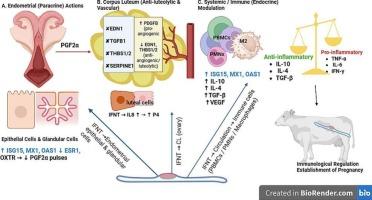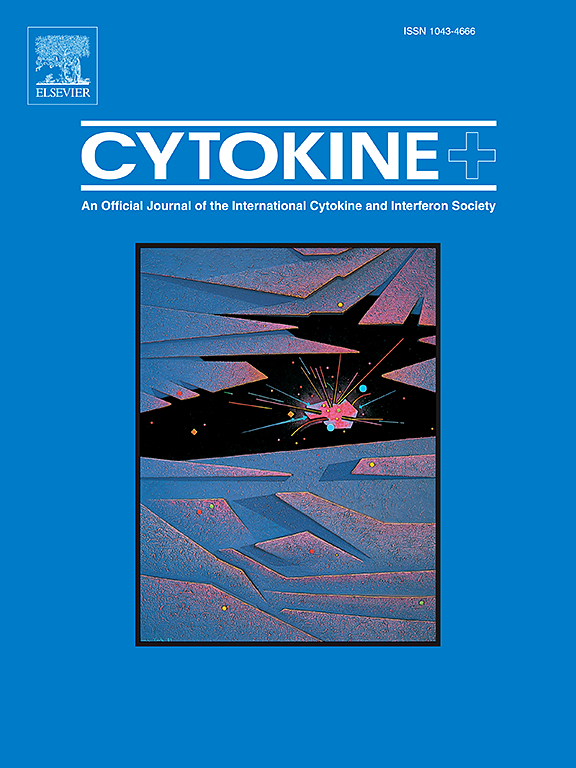Interferon tau in ruminant reproduction: Mechanisms of maternal recognition of pregnancy and implications for fertility enhancement
IF 3.7
3区 医学
Q2 BIOCHEMISTRY & MOLECULAR BIOLOGY
引用次数: 0
Abstract
Low conception rates and early embryonic loss remain major constraints to reproductive efficiency in ruminants, particularly during the peri-implantation period. Maternal recognition of pregnancy (MRP) is largely mediated by interferon tau (IFNT), a ruminant-specific type I interferon secreted by the elongating conceptus. Initially recognized for its anti-luteolytic action through suppression of endometrial prostaglandin F2α, (PGF2α). IFNT is now known to exert systemic effects beyond the uterus. It induces interferon-stimulated genes in endometrial and peripheral immune cells, shaping an immune environment conducive to embryo tolerance. By modulating nuclear factor kappa B, signal transducer and activator of transcription 1, and interferon regulatory factors, IFNT downregulates pro-inflammatory cytokines such as tumor necrosis factor alpha and interferon gamma, while enhancing anti-inflammatory mediators including interleukin-10 and interleukin-4. This shift promotes a T-helper 2-dominant immune profile favorable for maternal–fetal tolerance. In addition, IFNT safeguards corpus luteum function by mitigating PGF2α-induced luteolysis and preserving vascular integrity. This occurs through downregulation of pro-regression genes such as transforming growth factor beta 1, endothelin 1, thrombospondin 1/2, and serpin family E member 1, alongside upregulation of angiogenic mediators such as platelet-derived growth factor subunit B. These actions stabilize the luteal microenvironment and ensure sustained progesterone secretion. This review highlights IFNT's pivotal role in MRP, emphasizing its endocrine and paracrine actions on luteal maintenance, ISG induction, and immune modulation. It also explores IFNT's potential as a biomarker for early pregnancy detection and its applications in reproductive biotechnology, with bovine data supported by ovine, murine, and human models for translational insights.

干扰素tau在反刍动物繁殖中的作用:母体对妊娠的识别机制及其对提高生育能力的影响。
低受孕率和早期胚胎丢失仍然是制约反刍动物繁殖效率的主要因素,特别是在着床期。母体对妊娠的识别(MRP)主要由干扰素tau (IFNT)介导,IFNT是一种反刍动物特异性的I型干扰素,由妊娠延长分泌。最初发现其通过抑制子宫内膜前列腺素F2α (PGF2α)而具有抗黄体溶解作用。现在已知IFNT在子宫以外也有全身作用。它在子宫内膜和外周免疫细胞中诱导干扰素刺激基因,形成有利于胚胎耐受的免疫环境。IFNT通过调节核因子κ B、信号转导和转录激活因子1以及干扰素调节因子,下调促炎因子如肿瘤坏死因子α和干扰素γ,增强抗炎介质如白细胞介素-10和白细胞介素-4。这种转变促进了有利于母胎耐受的辅助性t - 2显性免疫谱。此外,IFNT通过减轻pgf2 α-诱导的黄体溶解和保持血管完整性来保护黄体功能。这是通过下调促回归基因,如转化生长因子β 1、内皮素1、血小板反应蛋白1/2和丝氨酸蛋白酶家族E成员1,以及上调血管生成介质,如血小板源性生长因子亚单位b来实现的。这些作用稳定了黄体微环境,并确保持续的孕酮分泌。本综述强调IFNT在MRP中的关键作用,强调其在黄体维持、ISG诱导和免疫调节方面的内分泌和旁分泌作用。它还探讨了IFNT作为早期妊娠检测生物标志物的潜力及其在生殖生物技术中的应用,牛的数据得到了羊、鼠和人类模型的支持,以获得转化见解。
本文章由计算机程序翻译,如有差异,请以英文原文为准。
求助全文
约1分钟内获得全文
求助全文
来源期刊

Cytokine
医学-免疫学
CiteScore
7.60
自引率
2.60%
发文量
262
审稿时长
48 days
期刊介绍:
The journal Cytokine has an open access mirror journal Cytokine: X, sharing the same aims and scope, editorial team, submission system and rigorous peer review.
* Devoted exclusively to the study of the molecular biology, genetics, biochemistry, immunology, genome-wide association studies, pathobiology, diagnostic and clinical applications of all known interleukins, hematopoietic factors, growth factors, cytotoxins, interferons, new cytokines, and chemokines, Cytokine provides comprehensive coverage of cytokines and their mechanisms of actions, 12 times a year by publishing original high quality refereed scientific papers from prominent investigators in both the academic and industrial sectors.
We will publish 3 major types of manuscripts:
1) Original manuscripts describing research results.
2) Basic and clinical reviews describing cytokine actions and regulation.
3) Short commentaries/perspectives on recently published aspects of cytokines, pathogenesis and clinical results.
 求助内容:
求助内容: 应助结果提醒方式:
应助结果提醒方式:


